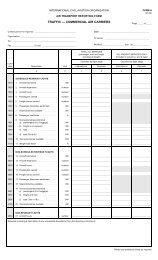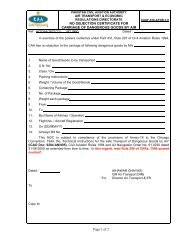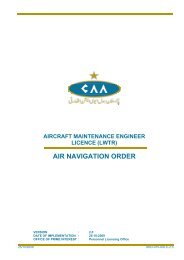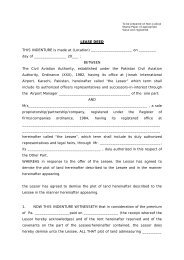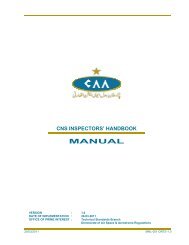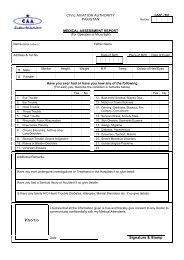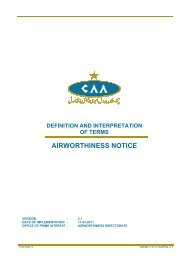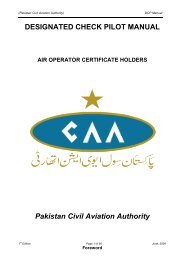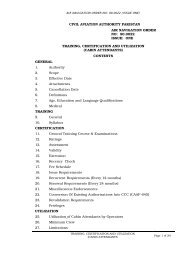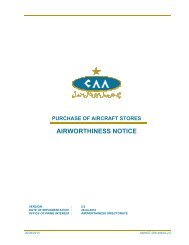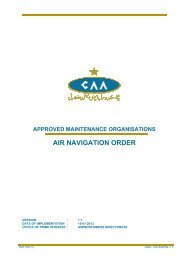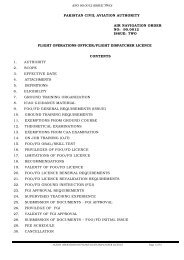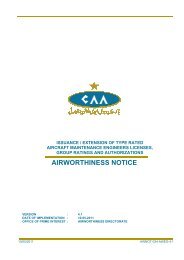state safety programme for pakistan manual - Civil Aviation Authority
state safety programme for pakistan manual - Civil Aviation Authority
state safety programme for pakistan manual - Civil Aviation Authority
Create successful ePaper yourself
Turn your PDF publications into a flip-book with our unique Google optimized e-Paper software.
STATE SAFETY PROGRAMME FOR PAKISTANMANUALVERSION : 1.0DATE OF IMPLEMENTATION : 15-03-2010OFFICE OF PRIME INTEREST : PRINCIPAL DIRECTORATE (REGULATORY)15/03/2010 MNL-001-PDRG-1.0
STATE SAFETY PROGRAMME FOR PAKISTAN15/03/2010 MNL-001-PDRG-1.0
STATE SAFETY PROGRAMME FOR PAKISTANForewordICAO Standards place a responsibility on ICAO contracting States to have a State SafetyProgramme (SSP). The <strong>programme</strong> is an integrated set of Regulations and activities aimed atimproving <strong>safety</strong>. Since Pakistan <strong>Civil</strong> <strong>Aviation</strong> <strong>Authority</strong> (PCAA) has regulatory responsibilities<strong>for</strong> aviation <strong>safety</strong>, we need to examine our legislations, policies and processes from the viewpoint of SSP. Although it may have been assumed that all is in order, the SSP may still revealissues that should be resolved to improve the way in which aviation <strong>safety</strong> is managed inPakistan.The SSP is based on comprehensive analyses of the State’s aviation system; <strong>state</strong> <strong>safety</strong>policies (based on hazard identification) and <strong>safety</strong> risk management. Also, <strong>safety</strong> oversight isfocused on the areas of significant <strong>safety</strong> concerns or higher <strong>safety</strong> risks. Thus, SSP provides themeans to combine prescriptive and per<strong>for</strong>mance-based approaches to <strong>safety</strong> rulemaking, policydevelopment and oversight by Pakistan.Principal Director (Regulatory) will coordinate to undertake the State Safety Programmedocumentations and help other departments to implement this Programme. Though mostessential elements of the <strong>safety</strong> framework are well established. However, a number of itemshave been identified <strong>for</strong> improvement and need concentrated ef<strong>for</strong>ts to work upon in relatedareas. Various tasks outlined in the <strong>programme</strong> need to be completed by concerned officials tomake SSP a wholesome subject under PCAA. It is <strong>for</strong> this reason that we plan to keep thisdocument up-to-date on PCAA website and we will work with our service providers to help themdevelop their Safety Management System Programme (SMS).I would like to thank and appreciate the members of State Safety Programme <strong>for</strong> undertaking thistask.15/03/2010 Page 1 of 24 MNL-001-PDRG-1.0
STATE SAFETY PROGRAMME FOR PAKISTANA. AUTHORITY:A1. This Manual has been issued under the authority vested in DG CAA under Rule 4(3) andall other enabling provisions of <strong>Civil</strong> <strong>Aviation</strong> Rules, 1994.B. PURPOSE:B1. This <strong>manual</strong> describes the State Safety Program <strong>for</strong> Pakistan.C. SCOPE:C1. This <strong>manual</strong> is applicable to all relevant directorates of PCAA as well as operators &service providers that are covered under ICAO annexes 1, 6, 7, 8, 11, 13 and 14.D. CORE RESPONSIBITIES:D1. The ICAO DOC-9859 SMM (Safety Management Manual) identifies annexes, which arerelevant when developing an SSP.D2. Table D2-1 describes the Annexes to the ICAO convention relevant to theimplementation of SSP and the concerned PCAA offices that are responsible <strong>for</strong>implementation of the <strong>manual</strong>.Annex No. Annex Title Concerned Officer1 Personnel Licensing GM Licensing6 Operations of Aircraft Dir Flight Standards7, 8 Airworthiness Dir A/W11 Air Traffic Services Dir Operations13 Aircraft Accident and Incident Investigation President SIB14 Aerodromes DAARE. DESCRIPTION:E1. DEFINITIONS:Table D2-1 Concerned PCAA offices and Relevant AnnexesE1.1 SSP is a <strong>programme</strong> <strong>for</strong> the aviation <strong>safety</strong> of a State.E1.2 SMS is a management tool <strong>for</strong> the management of <strong>safety</strong> by Service provider,aircraft operators and other stakeholders.E1.3 Safety is defined as the <strong>state</strong> in which the possibility of harm to persons or ofproperty damage is reduced to, and maintained at or below, an acceptable levelthrough a continuing process of hazard identification and <strong>safety</strong> riskmanagement.E1.4 Level of Safety is the degree of <strong>safety</strong> of a system. It is an emerging property ofthe system, which represents the quality of the system in terms of <strong>safety</strong>. It isexpressed through <strong>safety</strong> indicators.15/03/2010 Page 2 of 24 MNL-001-PDRG-1.0
STATE SAFETY PROGRAMME FOR PAKISTANE1.5 Safety Indicators are the parameters that characterize and/or typify the level of<strong>safety</strong> of a system.E1.6 Safety Targets are the concrete objectives of the level of <strong>safety</strong>.E1.7 Acceptable Level of Safety is the minimum degree of <strong>safety</strong> that must beassured by a system in actual practice.E1.8 Safety Indicator Value is the quantification of a <strong>safety</strong> indicator.E1.9 Safety Target Value is the quantification of a <strong>safety</strong> target.E1.10 Safety Measurement refers to the quantification of the outcomes of selectedhigh-level, high-consequence events, such as accident and serious incidentrates.E1.11 Safety Per<strong>for</strong>mance Measurement refers to the quantification of the outcomesof selected low-level, low-consequence processes, such as the number ofForeign object damages (FOD) events per specified number of ramp operations.E2. INTRODUCTION:E2.1 ICAO standards now require States to establish a State Safety Program (SSP) inorder to achieve an Acceptable Level of Safety (ALoS). They also explicitlyrequire States to establish an ALoS, as a means to verify satisfactoryper<strong>for</strong>mance of the service providers' Safety Management Systems (SMS). ICAOdescribes an SSP as 'an integrated set of regulations and activities aimed atimproving <strong>safety</strong>'.E2.2 The requirement <strong>for</strong> an SSP recognizes that States as well as service providers tohave <strong>safety</strong> responsibilities and provides a framework within which serviceproviders are required to establish SMS.E2.3 The early step in implementing an SSP is to develop a training proarmme <strong>for</strong> thepersonnel with an objective of providing knowledge of SSP including the ICAOSARPs contained in Annexes 1, 6, 7, 8 11, 13 & 14.E2.4 The first step in implementing an SSP specifically aimed at supporting SMSimplementation is the development of SMS requirements <strong>for</strong> service providers, aswell as guidance material <strong>for</strong> the development of a <strong>state</strong>’s regulations on SMSincluded in Appendix 1 to chapter 10 of SMM. Such guidance uses as reference;the components and elements of ICAO SMS Frame work discussed in chapter 8.E2.5 ICAO standards also require that the ALoS to be achieved is established by theState concerned. The concept of establishing an ALoS attempts to complementthe current approach to <strong>safety</strong> management based on regulatory compliance witha per<strong>for</strong>mance-based approach.E2.6 This document (Pakistan SSP) is developed using the ICAO SSP framework andguidance material, including the ICAO SSP gap analysis document. As much aspossible, the headings proposed by ICAO in its framework document are adoptedin this Publication.15/03/2010 Page 3 of 24 MNL-001-PDRG-1.0
STATE SAFETY PROGRAMME FOR PAKISTANE3. PAKISTAN AVIATION SAFETY OVER SIGHT ARRANGEMENTS:E3.1 INTRODUCTION:The purpose of this section is to describe the <strong>safety</strong> oversight arrangements inplace in Pakistan as an ICAO contracting State. It explains the relationshipsbetween Pakistan Government, civil aviation authority, service providers andICAO. This section also references the aviation <strong>safety</strong> regulatory legalframework in place in Pakistan.E3.2 PAKISTAN AS ICAO CONTRACTING STATE:E3.2.1 When Pakistan ratified the Convention on International <strong>Civil</strong> <strong>Aviation</strong> (theChicago Convention) and joined the club of ICAO Contracting <strong>state</strong>, the<strong>state</strong> aviation regulations and other Program within regulatory frameworkand activities had to ensure the discharge of the State ‘ s obligationsunder the Chicago Convention.E3.2.2 Pakistan as federal parliamentary system of government; has anelected President as the Head of the State and an elected PrimeMinister as the Head of the Government. The Parliament is the supremelegislative body of Pakistan, which consists of the Senate (Upper House)and the National Assembly (Lower House). The parliament is to enactstatutes or commonly known as act; when the parliament is not insession the President of Pakistan has the powers to make andpromulgate Ordinance. The Act of Parliament (termed as “Act”) and theOrdinance are the primary legislations.E3.2.3 The Primary <strong>Civil</strong> <strong>Aviation</strong> Legislation is the <strong>Civil</strong> <strong>Aviation</strong> Ordinance,1960 and Pakistan <strong>Civil</strong> <strong>Aviation</strong> <strong>Authority</strong> Ordinance, 1982, which issupplemented by provisions of <strong>Civil</strong> <strong>Aviation</strong> Rules 1994 being asecondary legislation.E3.2.4 Parliament of Pakistan has empowered Ministry of Defence (FederalGovernment) to issue and implement secondary civil aviation legislation.The secondary civil aviation legislation is known as <strong>Civil</strong> <strong>Aviation</strong> Rules,1994 (CARs). PCAA under the provision of <strong>Civil</strong> <strong>Aviation</strong> Rules (CARs)issues Regulations, which includes Air Navigation Orders, AirworthinessNotices, Air Safety Circulars, Aeronautical In<strong>for</strong>mation Publications andAeronautical In<strong>for</strong>mation Circulars etc.E3.2.5 PCAA provides air navigation services and aerodromes operations in allmajor civil airports of Pakistan except some small aerodromes which areappropriately licensed under CAR 94.These small aerodromes areowned by private corporations / companies / personnel like SialkotInternational Airport (owned by M/S. SIAL).Few military airfields aremanaged under joint user airfield policy <strong>for</strong> civil air transport.E3.2.6 PCAA regulatory framework endeavors to provide consistency andcompliance with the Annexes of the Chicago Convention within itsdomestic legislation i.e. <strong>Civil</strong> <strong>Aviation</strong> Ordinance, 1960 and <strong>Civil</strong> <strong>Aviation</strong>Rules, 1994. This framework ensures sound PCAA regulationscon<strong>for</strong>mity to the ICAO Requirements.15/03/2010 Page 4 of 24 MNL-001-PDRG-1.0
STATE SAFETY PROGRAMME FOR PAKISTANE3.3 RESPONSIBILITIES OF PCAA:E3.3.1 The PCAA is responsible <strong>for</strong> the <strong>safety</strong> regulations of the civil aviationindustry, development of policy on the sustainable use of Pakistanairspace and <strong>for</strong> ensuring the provision of necessary supportinginfrastructure <strong>for</strong> air navigation. The functions of the PCAA are definedin the <strong>Civil</strong> <strong>Aviation</strong> Ordinance 1960 & 1982, which is supplemented byspecific provisions of <strong>Civil</strong> <strong>Aviation</strong> Rules, 1994.E3.3.2 Legislative system of PCAA comprises three tiers:E3.3.2.1 The first tier is primary aviation legislation: This is comprisedof <strong>Civil</strong> <strong>Aviation</strong> Ordinance, 1960 and PCAA Ord. 1982.E3.3.2.2 The Second tier includes <strong>Civil</strong> <strong>Aviation</strong> Rules 1994, whichare issued by Ministry of Defence and implemented by theDirector General PCAA.E3.3.2.3 The third tier is supporting PCAA Regulations comprising AirNavigation Orders, Air Safety Circulars, AirworthinessNotices etc. These regulations are supplemented by theDirectors of concerned specialties like DirectorAirworthiness issues Airworthiness policy, etc.E3.3.3 All rules and regulations are updated to implement internationalobligations, adjusted to ICAO amendments and adopt latesttechnological as well as knowledge based developments /improvements.E3.3.4 The DG CAA is empowered under CARs 1994, to grant certificates,licenses and approvals <strong>for</strong> the safe operations of aircraft in accordancewith ICAO annexes as far permissible under CARs, 94 and supportingregulations.E3.4 ACCIDENT INVESTIGATION:E3.4.1 The Safety & Investigation Board (SIB) of Pakistan <strong>Civil</strong> <strong>Aviation</strong><strong>Authority</strong> is primarily responsible to conduct and participate in aircraftaccident / serious incident investigation where civil commercial /general aviation aircraft is involved in Pakistan and PakistaniRegistered aircraft outside Pakistan as per the enabling provisions of<strong>Civil</strong> <strong>Aviation</strong> Rules, 1994 and ICAO Annex-13 (Aircraft Accident &Incident Investigation).E3.4.2 The SIB with the necessary legal powers can conduct accidentinvestigations and fulfil Pakistan’s obligations in relation to ICAO Annex13 within the frame-work of CARs, 94.E3.4.3 The SIB is also responsible; to quickly respond to air accidents /serious incidents and to lead & manage the investigation team,conduct thorough, independent, impartial and timely investigations intoair accident / serious incidents including ATS (Operations)investigations, produce thorough and concise reports with well-foundedanalysis and conclusions without attributing blame or liability, andensure compliance with CARs 1994, ICAO Annex-13 and all otherstatutory and legal obligations in this regard.15/03/2010 Page 5 of 24 MNL-001-PDRG-1.0
STATE SAFETY PROGRAMME FOR PAKISTANE3.4.4E3.4.5It also facilitates Board of Accident Inquiries (BOAI) instituted by theFederal Government and assists to improve aviation <strong>safety</strong> in generalby educating and promulgating the lessons learnt from accidentinvestigations and take follow up actions on the investigationrecommendations.The Safety & Investigation Board is required to maintain close liaisonwith local military and <strong>for</strong>eign aviation agencies to improve aviation<strong>safety</strong> globally. The board is headed by the President Safety &Investigation Board (PSIB) and who directly reports to DG CAA.E3.5 SEARCH AND RESCUE (SAR):E3.5.1 Provision of search and rescue service as per <strong>Civil</strong> <strong>Aviation</strong> Rules, 1994is the responsibility of PCCA. PCAA may make arrangements <strong>for</strong> theestablishment, maintenance and operation of search and rescueservices <strong>for</strong> the purpose of, assisting aircraft which may be in need ofsearch and rescue assistance.E3.5.2 Search and rescue services to operate in compliance with theconvention shall be operating in pursuance of <strong>Civil</strong> <strong>Aviation</strong> Rules, 1994.E3.5.3 Director General PCAA may requisite aircraft, land vehicle ,or weathercraft and may engage persons to operate those crafts or vehicles <strong>for</strong> thepurpose of search and rescue operations in connection with search <strong>for</strong>missing aircraft or rescue of its crew and passengers .E4. PAKISTAN AVIATION SAFETY POLICY AND OBJECTIVES:E4.1 PAKISTAN AVIATION SAFETY POLICY:As per Article 44 of the Chicago convention PCAA <strong>safety</strong> Policy shall be in accordancewith international and national requirements. PCAA is committed to implement, developand improve strategies, management systems and processes to ensure that aviationoperations uphold the highest level of <strong>safety</strong> per<strong>for</strong>mance. This policy is communicated,with visible endorsement throughout the organization. The important elements of Safetypolicy are:-E4.1.1 Development of an embedded <strong>safety</strong> culture across all aviationindustries that recognizes the importance and value of effective aviation<strong>safety</strong> management and acknowledges at all times that <strong>safety</strong> isparamount.E4.1.2 To ensure that the PCAA financial and human resources are sufficient<strong>for</strong> implementation, establishment and maintenance of State’s SafetyProgramme.E4.1.3 To clearly define all regulatory staffs’ responsibilities and accountabilities<strong>for</strong> the implementation, establishment and maintenance of State SafetyProgramme and its per<strong>for</strong>mance.E4.1.4To ensure that all regulatory personal are provided with adequate andappropriate aviation <strong>safety</strong> in<strong>for</strong>mation and training. To further ensure15/03/2010 Page 6 of 24 MNL-001-PDRG-1.0
STATE SAFETY PROGRAMME FOR PAKISTANthat; they are competent specialists in their functional areas and haveadequate knowledge of <strong>safety</strong> regulations.E4.1.5 To establish a risk-based resource allocation strategy <strong>for</strong> all regulatoryfunctions (proactively targeting regulatory attention on known areas ofhigh risk) in the PCAA.E4.1.6 To ensure that acceptable levels of <strong>safety</strong> <strong>for</strong> aviation operations withinthe State are being set and achieved, and expressed in terms of <strong>safety</strong>per<strong>for</strong>mance indicators and <strong>safety</strong> per<strong>for</strong>mance targets.E4.1.7 To continually improve the State’s Safety Programme and <strong>safety</strong>per<strong>for</strong>mance.E4.1.8 To ensure that operators and service providers establish and maintainthe <strong>safety</strong> management system in their operation.E4.1.9 To achieve the highest levels of <strong>safety</strong> standards and per<strong>for</strong>mance inaviation operations.E4.1.10 To review the per<strong>for</strong>mance level and ensure continuous improvement.E4.2 PAKISTAN AVIATION SAFETY OBJECTIVES:In accordance with ICAO regulations PCAA has defined <strong>safety</strong> objectives to improve andrein<strong>for</strong>ce <strong>safety</strong>. In order to achieve a high level of <strong>safety</strong>, PCAA has developed thefollowing strategic objectives <strong>for</strong> aviation <strong>safety</strong>:-E4.2.1 PCAA regulates the <strong>safety</strong> of Pakistan civil aviation, by approving andoverseeing the organizations and individuals involved in Pakistani aviation.E4.2.2 PCAA will continue to use and develop a risk-based approach to ensure thatPakistan aviation sector complies with ICAO and PCAA legislation andrequirements.E4.2.3 PCAA will work collaboratively with industry to continuously improve aviation<strong>safety</strong> and address <strong>safety</strong> issues.E4.2.4 Where required, PCAA will take any necessary actions to ensure <strong>safety</strong> is notcompromised and will ensure that the high <strong>safety</strong> standards within Pakistanairspace and its supporting infrastructure is maintained with potential risksidentified and appropriate mitigating actions taken.E4.2.5 PCAA will draw upon worldwide and Pakistani data to identify <strong>safety</strong> trendsapplicable to Pakistan <strong>Civil</strong> aviation, prioritizing this in<strong>for</strong>mation to focus on themost significant <strong>safety</strong> issues; the resulting <strong>safety</strong> improvement initiatives will becaptured in the PCAA Safety Plan, which will be used as a means of monitoringprogress and effectiveness.E4.2.6 In order to achieve these objectives, PCAA has established comprehensive<strong>safety</strong> monitoring and planning processes to identify <strong>safety</strong> initiatives. It is alsocommitted to comply with all ICAO provisions <strong>for</strong> <strong>safety</strong> management systems.E4.3 PAKISTAN SSP RESPONSIBILITIES AND ACCOUNTABILITIES:E4.3.1 RESPONSIBILITIES:The State has identified and defined the PCAA’s requirements, responsibilitiesand accountabilities regarding the establishment and maintenance of the State’s<strong>safety</strong> <strong>programme</strong>. This includes the directives to plan, organize, develop,control and continuously improve the State’s <strong>safety</strong> <strong>programme</strong> in a manner thatmeets the State’s <strong>safety</strong> requirements. It also includes a clear <strong>state</strong>ment about15/03/2010 Page 7 of 24 MNL-001-PDRG-1.0
STATE SAFETY PROGRAMME FOR PAKISTANthe provision of the necessary human and financial resources <strong>for</strong> theimplementation of the State’s <strong>safety</strong> <strong>programme</strong>.E4.3.2E4.3.1.1REGULATORY RESPONSIBILITIES:E4.3.1.1 Regulatory responsibilities of Islamic Republic ofPakistan in civil aviation activities are:E4.3.1.2E4.3.1.3SARPs. Islamic Republic of Pakistan, as thesignatory to the Chicago Convention, isresponsible <strong>for</strong> implementation of ICAO SARPswithin the airspace and at aerodromes, subject toits domestic legislation in this regard.<strong>Civil</strong> <strong>Aviation</strong> <strong>Authority</strong> (CAA). Islamic Republicof Pakistan has established an appropriate body,referred to as the <strong>Civil</strong> <strong>Aviation</strong> <strong>Authority</strong> (CAA),with the necessary powers to ensure compliancewith the rules and regulations.E4.3.1.4 Safety oversight. Islamic Republic of Pakistan,has established appropriate <strong>safety</strong> oversightmechanisms to ensure that operators and serviceproviders maintain an acceptable level of <strong>safety</strong> intheir operations.E4.3.1.5 In the discharge of regulatory responsibilities ofIslamic Republic of Pakistan the CAA.E4.3.1.6 Represents a well-balanced allocation ofresponsibility between PCAA and the operators orservice providers <strong>for</strong> <strong>safety</strong>.E4.3.1.7 Is capable of economic justification within theresources of the PCAA.E4.3.1.8 Maintains continuing regulation and supervision ofthe activities of the operator or service providerwithout unduly inhibiting their effective directionand control of the organization; andE4.3.1.9 Endeavors <strong>for</strong> the cultivation and maintenance ofharmonious relationships between the PCAA andservice providers.ACCOUNTABILITIES:To promote a system of checks and balances that ensures <strong>safety</strong> has top priorityand a system of accountabilities are in place under jurisdiction of PCAA. Theregulations violators will be accountable <strong>for</strong> the act of violations or negligence.The system of accountability under the management of PCAA is supported bythe proper legal system of justice within legal framework of Islamic republic ofPakistan.E4.3.2.1E4.3.2.2To strengthen accountability system PCAA ensures that the PCAAfinancial and human resources are sufficient <strong>for</strong> implementation,establishment and maintenance of SSP.PCAA in accordance to ICAO SARPs and standards defined inAnnexes 1, 6, 7, 8, 11, 13 and 14 ensures management15/03/2010 Page 8 of 24 MNL-001-PDRG-1.0
STATE SAFETY PROGRAMME FOR PAKISTANE4.3.3E4.3.3.1E4.3.3.2accountability vis-à-vis the accepted <strong>safety</strong> management system.PCAA system clearly define the lines of <strong>safety</strong> accountability <strong>for</strong> theorganizations that are exposed to <strong>safety</strong> risks during delivery ofservices, aircraft operators, approved maintenance organizations,organizations responsible <strong>for</strong> type design and/or manufacture ofaircraft, air traffic service providers and certified aerodromes,including direct accountability <strong>for</strong> <strong>safety</strong> on the part of seniormanagement.ENFORCEMENT POLICY:PCAA has operators promulgated an en<strong>for</strong>cement policy that allowsService Providers to deal with, and resolve, events involving <strong>safety</strong>deviations and minor violations internally, within the context of theservice provider <strong>safety</strong> management system (SMS),to thesatisfaction of the PCAA.The aim of PCAA En<strong>for</strong>cement Policy is to lead the aviationcommunity in Pakistan by provision of a world-class air <strong>safety</strong>environment, which has public trust and confidence. To achieve trustand confidence of the aviation industry and the traveling public,PCAA has to react promptly and appropriately to the breaches ofCARs, 94 and En<strong>for</strong>cement Manual. CARs, 94 and En<strong>for</strong>cementManual provides following objectives:E4.3.3.2.1 A greater range of en<strong>for</strong>cement actions to better matchthe regulatory action to the seriousness of the breach.E4.3.3.2.2 Greater accountability by PCAA regarding its decisions.E4.3.3.2.3 Greater impartiality and justifiability in decision makingby having some of PCAA powers subject to an order ofa court.E4.3.3.2.4 On one hand, facilitate the service providers in theirobjectives of safe and efficient flight operations withgrowth, service to the community whilst, on the otherhand, give PCAA a balanced but measured capacity tomake the tough decisions when they have to be madeto en<strong>for</strong>ce aviation <strong>safety</strong>.E4.3.3.3E4.3.3.4These objectives must be accompanied by explicit benchmarks anda capacity within aviation activities to demonstrate in a measurableand accountable way how and when these objectives will be met.CAA’s en<strong>for</strong>cement policy determines the way PCAA uses itspowers to regulate. With limited resources PCAA has to ensure thatit gives proper focus to the exercise of these powers.The en<strong>for</strong>cement procedure includes provisions <strong>for</strong> the PCAA todeal with events involving gross negligence and willful deviationsthrough established en<strong>for</strong>cement procedures.E4.3.3.4.1 The CARs confers on the DG CAA the power ofen<strong>for</strong>cement and this power may be delegated to thesubordinate CAA Officers.E4.3.3.4.2 Breach of the CARs is a criminal offence carrying acorresponding maximum penalty which depends on thenature and circumstances of the breach.E4.3.3.4.3 Although the PCAA Requirements do not themselvesconstitute legislation or regulations, they are the means15/03/2010 Page 9 of 24 MNL-001-PDRG-1.0
STATE SAFETY PROGRAMME FOR PAKISTANE4.3.4E4.3.4.1E4.3.4.2E4.3.4.3E4.3.5by which the PCAA can be satisfied as to the basis <strong>for</strong>the issue or maintenance of a licence, certificate orapproval.E4.3.3.4.4 Non-compliance with the PCAA Regulations may result inthe PCAA revoking a licence, certificate or approval,refusing to grant a licence, certificate or approval orgranting a licence, certificate or approval with conditions.ADMINISTRATIVE MEASURES:Almost every aspect of aviation activity is subject to anauthorization. Pilots, aircraft maintenance engineers and air trafficcontrollers must have a license. Commercial aircraft operators andair navigation service providers must have a licence and certificate.Public aerodromes must be licensed and certified. Organizationswhich design produce or maintain aircraft must be approved.Individual aircraft must have a certificate of airworthiness or permitto fly.All the permissions issued so far as individuals and organizationsare concerned in Pakistan by PCAA are in accordance with legalrequirements and standards defined by ICAO Annexes withinprovisions of CARs, 94.The PCAA has powers to vary, suspend or revoke permission whereit is no longer satisfied that the relevant criteria are met. Forexample, it will suspend a flight crew license where it is no longersatisfied that the holder is fit or competent to exercise its privileges.Where it takes license suspension action, the PCAA is obliged tooffer a right of appeal. The appeal procedure is contained inconcerned ANOs / En<strong>for</strong>cement Manual.ENFORCEMENT MANUAL:En<strong>for</strong>cement Manual describes the circumstances in which the en<strong>for</strong>cement canor must be made to deal with an identified breach of the Rules and Regulations.The subject-specific sections of the En<strong>for</strong>cement Manual and the Rules /Regulations, which govern the en<strong>for</strong>cement tools, are based on the followingprinciples:-E4.3.5.1E4.3.5.2E4.3.5.3Natural Justice and Accountability: En<strong>for</strong>cement decisions mustbe:E4.3.5.1.1 Based on fair observance of due process.E4.3.5.1.2 Transparent to those involved.E4.3.5.1.3 Consistent in the like circumstances so as to be nondiscriminatory.E4.3.5.1.4 Subject to appropriate internal and external review.Impartiality: En<strong>for</strong>cement decisions must not be influenced by:E4.3.5.2.1 Personal conflict.E4.3.5.2.2 Extraneous considerations (such as gender, race,religion, political views or affiliation); orE4.3.5.2.3 The personal, political or financial power of thoseinvolved.Proportionality: En<strong>for</strong>cement decisions must be proportionalresponses to the identified breaches and the <strong>safety</strong> risk they give riseto. In particular:E4.3.5.3.1 CAA’s first priority is to protect the <strong>safety</strong> of fare-payingpassengers;15/03/2010 Page 10 of 24 MNL-001-PDRG-1.0
STATE SAFETY PROGRAMME FOR PAKISTANE4.3.5.3.2 PCAA will take strong action against those whoconsistently and deliberately operate outside / beyondthe <strong>Civil</strong> <strong>Aviation</strong> Rules and Regulations;E4.3.5.3.3 PCAA will seek to educate and promote training orsupervision of those who display a lack of proficiency,but have a willingness to comply with the <strong>Civil</strong> <strong>Aviation</strong>Rules and Regulations;E4.3.5.3.4 PCAA will issue a Show Cause Notice (SCN), instead ofimmediate suspension / cancellation of license whendealing with holders of license, certificate orauthorization who breach the Rules / Regulations.E4.3.6E4.3.6.1E4.3.6.2E4.3.6.3PROSECUTION:A failure to comply with any of the requirements of the CARs, 94 anAir Navigation Order (ANO) and related Regulations or specifiedaviation <strong>safety</strong> regulations will be considered as criminal offence. TheChief Legal Directorate of PCAA undertakes the task of prosecutingthe offenders. However, in most of the cases, financial penalty isimposed.The CAA's prosecution policy is based on compliance with the CARs,94. The task of deciding which cases to investigate is undertaken bythe DGCAA.The PCAA has limited resources and cannot investigate every reportwhich it receives. However, all incidents and accidents areinvestigated by Safety Investigation Board which works underDGCAA.E5. PAKISTAN AVIATION SAFETY RISK MANAGEMENT PROCESS:E5.1 PCAA SAFETY PLAN AND SAFETY RISK MANAGEMENT PROCESS:E5.1.1 One of PCAA's objectives is to sustain Pakistan aviation <strong>safety</strong> per<strong>for</strong>mancethrough continuous improvements. PCAA Safety Regulation Group is workingunder the guidance of Principle Director (Regulatory). A strategic agendadefined <strong>for</strong> <strong>safety</strong> is under consideration to be implemented through its SafetyPlan and Safety Plan Updates. PCAA is committed to engage with otherstakeholders / partners to ensure that complementary <strong>safety</strong> goals are achieved.E5.1.2 The Safety Risk Management Process will be used by PCAA to determine whataction could be taken to help mitigate those risks. The combination of the twoprocesses may result in a set of actions contained in Safety Plan. It will also serveto demonstrate PCAA's commitment to continuously developing its processes tohelp improve <strong>safety</strong>.E5.1.3 The PCAA will produce a <strong>for</strong>mal Safety Plan. The Safety Planning process willuse expertise of organization’s expert in the concerned area to identify potentialrisks, starting with the major risks as evidenced in the data, using MandatoryOccurrence Reports and other data sources.E5.1.4 As regard PCAA Safety Risk Management Process, the risk management will bethrough analyses of <strong>safety</strong> data from the data bank and produce a <strong>safety</strong>analysis documents. The main significant document will be the Global FatalAccident Review. This would contain a detailed study of worldwide fatalaccidents to jet and turboprop airplanes above 5,700kg engaged in passenger,cargo and ferry/positioning flights <strong>for</strong> the ten year period.E5.1.5 To identify risk and define actions to reduce risk factors relevant to aviationindustry of Pakistan will be focus of PCAA <strong>for</strong> the per<strong>for</strong>mance improvement ofthe industry.15/03/2010 Page 11 of 24 MNL-001-PDRG-1.0
STATE SAFETY PROGRAMME FOR PAKISTANE5.1.6 The PCAA regulatory framework in which it operates may change according tothe rapid technological or any other change factors; will induce changes.However PCAA will remain focused on <strong>safety</strong> improvement adopting thechanges as per the requirement of change suitable to its environment.E5.1.7 Safety improvements may not be very effective without the involvement andgood relationship of all sectors of Pakistan aviation industry. PCAA isdetermined to build on that relationship with industry through greater involvementfrom industry in the development of the Safety Plan and to share <strong>safety</strong> issuesas the results of that partnership.E5.2 PCAA SAFETY RISK TEAM:E5.2.1 To oversee aviation <strong>safety</strong> risks and identify the hazards, PCAA has establishedDirectorate of Safety and Quality Management System (SQMS) which works asthe Safety Risk Team (SRT). The SRT provides high-level oversight of and coordinatesthe <strong>safety</strong> risk management process. It is key to the success of the SRTand the management of risk in PCAA as a whole that the team is direct,proactive, delivers high quality in<strong>for</strong>mation, advice and proposes direction tosenior management.E5.2.2 The SQMS is tasked to seek and review <strong>safety</strong> in<strong>for</strong>mation and identify riskissues that are of strategic importance, ensure appropriate action plans areidentified to mitigate these risks, and propose documented <strong>safety</strong> plans to seniormanagement <strong>for</strong> their approval. The SQMS aims to assess the tolerability ofaviation risks using both objective and subjective methods.E5.2.3 In particular the SQMS is tasked to:E5.2.3.1 Identify risks.E5.2.3.2 Assess identified risks and supporting data.E5.2.3.3 Identify new and potential <strong>safety</strong> data sources and data handlingmethods.E5.2.3.4 Review and comment on the PCAA SRG Safety Per<strong>for</strong>manceIndicators paper, sponsoring further work where required.E5.2.3.5 Assess mitigating actions.E5.2.3.6 Share and co-ordinate <strong>safety</strong> in<strong>for</strong>mation amongst all PCAA wings(regulatory, ANS and Airport Services).E5.2.3.7 Be briefed with the aim of exploring possible new approaches oractions that may be adopted.E5.2.3.8 Constitute cross-functional team to assess specific issues andrecommend potential action plans to the SRT.E5.2.3.9 Agree and implement the methods to be used in preparing full SafetyPlans and Safety Plan Updates.E5.2.3.10 Contribute to and where possible improve Pakistan wide Safety RiskManagement.E5.3 SAFETY REQUIREMENTS FOR SERVICE PROVIDERS’ SMS:E5.3.1 The full impact of SMS on regulatory oversight has yet to be fully considered. Itis, there<strong>for</strong>e, important that PCAA management officials with oversightresponsibilities <strong>for</strong> service providers’ SMS have a common and clearunderstanding of the fundamental principles of SMS. In response, Directorate ofSQMS has arranged internal SMS training <strong>for</strong> PCAA personal.15/03/2010 Page 12 of 24 MNL-001-PDRG-1.0
STATE SAFETY PROGRAMME FOR PAKISTANE5.3.2 To assist service providers on implementation of SMS and on methods toidentify operational hazards, the PCAA will publish guidance documents. As thisis a developing concept and Pakistan does not wish to develop its own conceptof SMS, especially to avoid problems when subjected to other internationalstandardization audits, much reliance is being placed on the ICAO SMS.E5.3.3 In view of the developing nature of SMS, PCAA will regularly review therelevance of all guidance material. This work is overseen by PCAA's SQMSGroup.E5.3.4 For airline operators, service providers and approved maintenanceorganizations, the ICAO Standard requires SMS from 1 January 2009. Inresponse to this, PCAA is promoting the implementation of SMS and iscontributing towards the development of implementing new Rule, which willprovide the legal basis <strong>for</strong> mandating SMS across Pakistan. The Air navigationservice Providers, Aerodrome operators and Aircraft Maintenance organizationsAircraft Operators and other service providers shall have in place <strong>safety</strong>management system in their operation by 19 th November 2010. The operatorsand service provider shall also develop the SMS implementation planconsidering a phased approach of its implementation and shall be approved bythe PCAA.E5.3.5 All service providers shall implement hazard identification and <strong>safety</strong> riskmanagement process to maintain their level of <strong>safety</strong>.E5.3.6 For ANSPs, PCAA has established SMS requirements <strong>for</strong> ANSPs under SafetyRegulatory Requirements. ANSP is now required to employ SMS.E5.3.7 For airport operators the requirements do establishment of SMS exists in theCAA's aerodrome licensing criteria.E5.3.8 For airline operators and approved maintenance organizations, the ICAOStandard requires implementation of SMS from 19 th November 2010. Inresponse to this, PCAA is promoting the implementation of SMS by airlineoperators and maintenance organizations.E5.3.9 <strong>Aviation</strong> organization are often required to develop, implement and operate; anumber of different management systems like QMS, EMS, OHSMS, SEMS etc.to achieve their production and service goals. The stand-alone operation ofthese systems do add value to the organization. However, the integration ofsystems provides benefits; reduction of duplication, cost, organizational risk, andelimination of potential conflicts etc. In response to this the <strong>Aviation</strong>organizations are encouraged to integrate their management systems <strong>for</strong> quality,<strong>safety</strong>, security, occupational health and <strong>safety</strong>, and environmental protectionmanagement etc.E5.4 APPROVAL OF SERVICE PROVIDER’S ACCEPTABLE LEVELS OF SAFETY:E5.4.1 ACCEPTABLE LEVELS OF SAFETY:E5.4.1.1 Acceptable Levels of Safety (ALoS) relates to an SSP or SMS shouldbe the means to verify the operational per<strong>for</strong>mance of an SMS.E5.4.1.2 The move to both SSP and SMS reflects a fundamental regulatorychange to complement the compliance-based approach with aper<strong>for</strong>mance-based approach.E5.4.1.3 It is no longer possible to assume that regulatory compliance alonewill produce <strong>safety</strong> improvements. A more pro-active, per<strong>for</strong>mancebasedapproach is necessary to achieve continuous <strong>safety</strong>improvement. To do this requires both the regulator and serviceprovider to establish and monitor objective <strong>safety</strong> per<strong>for</strong>mance15/03/2010 Page 13 of 24 MNL-001-PDRG-1.0
STATE SAFETY PROGRAMME FOR PAKISTANindicators, to establish <strong>safety</strong> per<strong>for</strong>mance targets and to take action,where necessary, to improve <strong>safety</strong>.E5.4.1.4 ICAO uses following three elements to define an acceptable level of<strong>safety</strong> <strong>for</strong> use both in an SSP and in a service provider's SMS.E5.4.1.4.1E5.4.1.4.2E5.4.1.4.3E5.4.1.4.4E5.4.1.4.5E5.4.1.4.6E5.4.1.4.7Safety per<strong>for</strong>mance indicators (SPI): these are shortterm,tactical measurable <strong>safety</strong> per<strong>for</strong>mance outcomesof the <strong>safety</strong> per<strong>for</strong>mance of an aviation organization ora sector of the industry. They are expressed innumerical terms. These are the measures (or metrics)used to express the <strong>safety</strong> per<strong>for</strong>mance in a system.They should be uncomplicated, easy to measure andenable linkage between the Safety Plan and anoperator’s/service provider ’ s SMS. They will there<strong>for</strong>ediffer between segments of industry, such as aircraftoperators, aerodrome operators or ATS providers.Safety per<strong>for</strong>mance targets (SPT): these are longterm,strategic measurable <strong>safety</strong> per<strong>for</strong>manceoutcomes of the <strong>safety</strong> per<strong>for</strong>mance of an aviationorganization or a sector of the industry. They areexpressed in numerical terms. Represent the desiredlevel of <strong>safety</strong> per<strong>for</strong>mance. A <strong>safety</strong> per<strong>for</strong>mance targetcomprises one or more <strong>safety</strong> per<strong>for</strong>mance indicators,together with desired outcomes expressed in terms ofthose indicators. These are necessarily determined byconsidering what <strong>safety</strong> per<strong>for</strong>mance levels aredesirable and realistic <strong>for</strong> individual serviceproviders/operators. SPT should be measurable andacceptable to the parties involved.Safety requirements: these are the tools and mean toachieve the <strong>safety</strong> per<strong>for</strong>mance indicators and targets ofan SSP. They include operational procedures,technology, systems and <strong>programme</strong>s to whichmeasures of reliability, availability, per<strong>for</strong>mance and/oraccuracy can be specified.The acceptable level of <strong>safety</strong> to be achieved shall beestablished by the Regulators. However, theestablishment of an ALoS should involve close liaisonbetween the Regulator and service providers so thatboth the SSP and service providers SMS have similarALoS.In determining an ALoS, it is necessary to considervarious factors such as the level of <strong>safety</strong> risk thatapplies the cost/benefits of improvements to the system,and public expectations on the <strong>safety</strong> of the aviationindustry.The ALoS will also be commensurate with thecomplexity of individual service provider's specificoperational contexts and their availability of resources toaddress <strong>safety</strong> risks.The agreed ALoS will be expressed by multiple <strong>safety</strong>per<strong>for</strong>mance indicators and <strong>safety</strong> per<strong>for</strong>mance targets,never by a single one, as well as by <strong>safety</strong> requirementsin the <strong>for</strong>m of remedial actions.15/03/2010 Page 14 of 24 MNL-001-PDRG-1.0
STATE SAFETY PROGRAMME FOR PAKISTANE5.5 PAKISTAN IMPLEMENTATION OF SSP:E5.4.1.4.8 The ALoS should be reviewed periodically to ensure theyremain relevant and appropriate to the service providers.E5.4.1.4.9 The concept of acceptable level of <strong>safety</strong> responds tothe need to complement the prevailing approach to themanagement of <strong>safety</strong> based upon regulatorycompliance, with a per<strong>for</strong>mance-based approach.E5.4.1.4.10 Acceptable level of <strong>safety</strong> expresses the <strong>safety</strong> goals (orexpectations) of the PCAA, an operator or a serviceprovider.E5.4.1.4.11 From the perspective of the relationship between thePCAA and operators/service providers, it provides anobjective in terms of the <strong>safety</strong> per<strong>for</strong>manceoperators/service providers should achieve whileconducting their core business functions, as a minimumacceptable to the PCAA. It is a reference against whichthe PCAA can measure <strong>safety</strong> per<strong>for</strong>mance.E5.4.1.4.12 In determining an acceptable level of <strong>safety</strong>, it isnecessary to consider such factors as the level of riskthat applies, the cost/benefits of improvements to thesystem, and public expectations on the <strong>safety</strong> of theaviation industry.E5.4.1.4.13 The acceptable level of <strong>safety</strong> is expressed by twomeasures/metrics (<strong>safety</strong> per<strong>for</strong>mance indicators and<strong>safety</strong> per<strong>for</strong>mance targets) and implemented throughvarious <strong>safety</strong> requirements.E5.5.1 Based on the <strong>manual</strong> published by ICAO, an action plan was developed and ispresented in Table E5-2.E5.5.2 A time line <strong>for</strong> implementing the action plan was <strong>for</strong>mulated and divided intothree phases. Tasks were then allotted to each phase. The details of this timeline are given in Table E5-1.Phase Phase 1 Phase 2 Phase 3Time 3 Months 9 Months 12 MonthsTotal TimeTwo yearsTable E5 - 1 Phase DurationE5.5.3 In developing this plan, many factors were brought into consideration.These include:E5.5.3.1 ICAO requirements & recommendations.E5.5.3.2 Domestic Culture & existing setup.E5.5.3.3 Budget & Manpower constraints.E5.5.3.4 Domestic Service provider.E5.5.3.5 Modern Management techniques.E5.5.3.6 Explicit and traceable documentation.15/03/2010 Page 15 of 24 MNL-001-PDRG-1.0
STATE SAFETY PROGRAMME FOR PAKISTANTASKPHASEConduct Gap analysis as per chapter 11.6.2 of ICAO <strong>safety</strong> management <strong>manual</strong>. Phase 11. STATE SAFETY POLICY AND OBJECTIVES1.1 State <strong>safety</strong> legislative frameworka) Review, develop and promulgate a national <strong>safety</strong> legislative framework and specificregulations, in compliance with international and national standards.b) Establish a national-level group within the State in the <strong>for</strong>m of a steering committee, toensure the coordinated participation of State aviation organizations in specific activitiesrelated to the management of <strong>safety</strong> in the State, and the establishment of the roles,responsibilities and relationships of such organizations.c) Establish a time frame to periodically review the <strong>safety</strong> legislation and specific operatingregulations to ensure they remain relevant and appropriate to the State.1.2 State <strong>safety</strong> responsibilities and accountabilitiesa) Identify, define and document the requirements, responsibilities and accountabilitiesregarding the establishment and maintenance of the SSP. This includes the directives toplan, organize, develop, maintain control of and continuously improve the SSP in a mannerthat meets the State’s <strong>safety</strong> objectives. Include a clear <strong>state</strong>ment about the provision of thenecessary resources <strong>for</strong> the implementation of the SSP.b) Identify and appoint the Accountable Executive of the State SSP who shall have amongother responsibilities:1) Ultimate responsibility and accountability, on behalf of the State, <strong>for</strong> the implementationand maintenance of the SSP;2) Full authority on human resources issues related to the State aviation organization thathas been designated as placeholder <strong>for</strong> the SSP;3) Full authority on major financial issues related to State aviation organization that hasbeen designated as placeholder <strong>for</strong> the SSP;4) Final authority over service provider’s certificate management aspects.5) Final responsibility <strong>for</strong> the resolution of all aviation <strong>safety</strong> issues of the State.Phase 1Phase 1Phase 1Phase 1Phase 1c) Establish the SSP implementation team. Phase 1d) Assign the time required <strong>for</strong> each task associated with the implementation of the SSPPhase 1among the different management levels of the State aviation organizations.e) Introduce all staff to SSP concepts at a level commensurate with their involvement in thePhase 2SSP.f) Revise the <strong>state</strong> <strong>safety</strong> policy as per SMM. Phase 1g) Establish the necessary means to ensure that the State <strong>safety</strong> policy is understood,Phase 2implemented and observed at all levels within State aviation organizations.1.3 Accident and incident investigationa) Develop and establish the mechanisms to ensure an independent accident and incidentinvestigation process, the sole objective of which is the prevention of accidents andPhase 1incidents, in support of the management of <strong>safety</strong> in the State, and not the apportioning ofblame or liability.b) Develop and establish the necessary arrangements to ensure the independence of thePhase 1accident and incident investigation authority from other aviation organizations of the State.1.4 En<strong>for</strong>cement policya) Develop and promulgate an en<strong>for</strong>cement policy that establishes the conditions andcircumstances under which service providers are allowed to deal with, and resolve, eventsinvolving certain <strong>safety</strong> deviations, internally, within the context of the service provider’s Phase 1<strong>safety</strong> management system (SMS), and to the satisfaction of the appropriate State authority.The en<strong>for</strong>cement policy also establishes the conditions and circumstances under which to15/03/2010 Page 16 of 24 MNL-001-PDRG-1.0
STATE SAFETY PROGRAMME FOR PAKISTANdeal with <strong>safety</strong> deviations through established en<strong>for</strong>cement procedures. The policy shouldalso ensure that no in<strong>for</strong>mation obtained from an internal hazard reporting system or a flightdata monitoring system established under an SMS will be used <strong>for</strong> en<strong>for</strong>cement action.1.5 SSP documentationa) Develop and establish a State <strong>safety</strong> library that documents the requirements,responsibilities and accountabilities regarding the establishment and maintenance of theSSP. The <strong>safety</strong> library will maintain and update, as necessary, the SSP documentationrelated to the national <strong>safety</strong> legislative framework, the State <strong>safety</strong> policy and objectives, Phase 2the SSP requirements, the SSP processes and procedures, the accountabilities,responsibilities and authorities <strong>for</strong> processes and procedures, and the <strong>state</strong>’s acceptablelevel of <strong>safety</strong> (ALoS) related to the SSP.2. STATE SAFETY RISK MANAGEMENT2.1 Safety requirements <strong>for</strong> the service provider’s SMSa) Establish the requirements, specific operating regulations and implementation policies <strong>for</strong>the service provider’s SMS (SMS regulatory framework, advisory circulars, etc.) as thePhase 1controls which govern how service providers will identify hazards and manage and control<strong>safety</strong> risks.b) Establish a time frame <strong>for</strong> consultation with service providers on those requirements. Phase 2c) Establish a time frame to periodically review the requirements and specific operatingPhase 2regulations to ensure they remain relevant and appropriate to the service providers.2.2 Agreement on the service provider’s <strong>safety</strong> per<strong>for</strong>mancea) Develop and establish a procedure <strong>for</strong> agreement on the <strong>safety</strong> per<strong>for</strong>mance of anindividual service provider’s SMS based on:1) Safety per<strong>for</strong>mance indicator values.Phase 12) Safety per<strong>for</strong>mance target values.3) Action plans.b) Include within the agreed procedure that the service provider’s <strong>safety</strong> per<strong>for</strong>mance shouldbe commensurate with:Phase 11) The complexity of the individual service provider’s specific operational contexts.2) The availability of the individual service provider’s resources to address <strong>safety</strong> risks.c) Measure the <strong>safety</strong> per<strong>for</strong>mance of the service provider’s SMS through periodic reviewsof the agreed <strong>safety</strong> per<strong>for</strong>mance of the SMS to ensure that <strong>safety</strong> per<strong>for</strong>mance indicators Phase 3and <strong>safety</strong> per<strong>for</strong>mance targets remain relevant and appropriate to the service provider.d) Develop a means to assess lower-level outcomes and most frequent processes amongPhase 3different service providers.e) Determine measurable per<strong>for</strong>mance outcomes within different SMS. Phase 33. STATE SAFETY ASSURANCE3.1 Safety oversighta) Establish mechanisms to ensure an effective <strong>safety</strong> oversight function. Phase 2b) Establish mechanisms that guarantee that the identification of hazards and thePhase 2management of <strong>safety</strong> risks by service providers follow established regulatory controls.c) Establish mechanisms that guarantee that <strong>safety</strong> risk controls are integrated into thePhase 2service provider’s SMS.d) Develop an internal SSP audit. Phase 33.2 Safety data collection, analysis and exchangea) Develop and establish a software <strong>for</strong> collecting, analysing and storing data about hazardsand <strong>safety</strong> risks at the State level:1) Establish a mandatory hazard reporting system.2) Establish a confidential hazard reporting system.3) Develop a State hazard database.4) Establish a mechanism to develop in<strong>for</strong>mation from the stored data.Phase 215/03/2010 Page 17 of 24 MNL-001-PDRG-1.0
STATE SAFETY PROGRAMME FOR PAKISTAN5) Establish a means to collect hazards at both the aggregate State level and at theindividual service provider’s level.6) Establish a means to implement corrective action plans.b) Ensure that the service provider’s hazard identification and <strong>safety</strong> risk managementprocesses follow established regulatory requirements and that <strong>safety</strong> risk controls areappropriately integrated into the service provider’s SMS, including, but not necessarilylimited to:1) Inspections;2) Audits; and3) Surveys.d) Establish the acceptable level of <strong>safety</strong> (ALoS) related to the SSP, comprising of <strong>safety</strong>measurement:1) Safety measurement includes the quantification of the outcomes of high-level, highconsequenceevents or high-level State functions, such as accident rates, seriousincident rates and regulatory compliance.2) Identification of <strong>safety</strong> indicators.3) Quantification of <strong>safety</strong> indicators.4) Determine current level of <strong>safety</strong>.5) Set values of <strong>safety</strong> targets.6) Determine acceptable level of <strong>safety</strong>.d) Establish the acceptable level of <strong>safety</strong> (ALoS) related to the SSP, comprising of <strong>safety</strong>per<strong>for</strong>mance measurement:1) Safety per<strong>for</strong>mance measurement includes the quantification of the outcomes oflow-level, low-consequence processes that provides a measure of the realisticimplementation of an individual SSP beyond accident rates and/or regulatorycompliance.2) Identification of <strong>safety</strong> per<strong>for</strong>mance indicators.3) Quantification of <strong>safety</strong> per<strong>for</strong>mance indicators.4) Determine current level of <strong>safety</strong>.5) Set values of <strong>safety</strong> per<strong>for</strong>mance targets.6) Determine acceptable level of <strong>safety</strong>.e) Develop the action plan to implement ALoS i.e. to develop the tools and means needed toachieve the <strong>safety</strong> target values of ALoS related to an SSP. It also includes the operationalprocedures, technology, systems and programs to which measures of reliability, availability,per<strong>for</strong>mance and/or accuracy can be specified.Phase 2Phase 2Phase 3Phase 33.3 Safety-data-driven targeting of oversight of areas of greater concern or needa) Establish procedures to prioritize inspections, audits and surveys, based on analysis ofPhase 3hazards and <strong>safety</strong> risks.4. STATE SAFETY PROMOTION4.1 Internal training, communication and dissemination of <strong>safety</strong> in<strong>for</strong>mationa) Identify internal training requirements. Phase 1b) Develop and provide generic <strong>safety</strong> training to all staff. Phase 1c) Develop a training program on key components of an SSP and an SMS <strong>for</strong> staff thatincludes:1) Indoctrination/initial <strong>safety</strong> training;2) On-the-job (OJT) <strong>safety</strong> training;3) Recurrent <strong>safety</strong> training.Phase 1d) Establish a means to measure the effectiveness of the training. Phase 2e) Develop a means to communicate <strong>safety</strong>-related issues internally, including:1) Safety policies and procedures.2) Newsletters.3) Bulletins.4) A website.Phase 315/03/2010 Page 18 of 24 MNL-001-PDRG-1.0
STATE SAFETY PROGRAMME FOR PAKISTAN4.2 External training, communication and dissemination of <strong>safety</strong> in<strong>for</strong>mationa) Establish the means to provide two-way communication of <strong>safety</strong>-relevant in<strong>for</strong>mation toPhase 1support SMS implementation among service providers, including small operators.b) Develop training and guidance material on implementation of SMS <strong>for</strong> service providers. Phase 2c) Establish the means to communicate <strong>safety</strong>-related issues externally including:1) Safety policies and procedures;2) Newsletters;Phase 33) Bulletins; and4) A website.Table E5 - 2: SSP Implementation PlanE5.6 PAKISTAN IMPLEMENTATION OF SMS:E5.6.1 ICAO has outlined a phased implementation of a service providers SMS. Thisphased approach provides service providers with a manageable series of stepsto follow when implementing SMS and helps to manage the workload associatedwith SMS implementation. The phased approach recommended by ICAO has thefollowing four phases:E5.6.1.1E5.6.1.2E5.6.1.3E5.6.1.4Phase A - Planning SMS Implementation.Phase B - Reactive <strong>safety</strong> management processes.Phase C - Proactive and predictive <strong>safety</strong>.Phase D - Operational <strong>safety</strong> assurance.E5.6.2 A phased approach to the implementation of SMS is being promoted by PCAA.Such an approach will recognize the timescale required to develop, implementand verify the effectiveness of an SMS taking account of the size and complexityof an organization. The timescale <strong>for</strong> Pakistan legislation mandating SMS <strong>for</strong> airoperators and maintenance organizations has yet to be established.E5.7 CHANGE MANAGEMENT:E5.7.1 <strong>Aviation</strong> is in a continuous <strong>state</strong> of change, with advances in technology and achanging business and regulatory context. Regulatory staff raises issues arising intheir areas of specialization through management. This may result in measuressuch as:-E5.7.1.1 Research to provide objective evidence of the nature and extent ofissues arising.E5.7.1.2 Specific promotion of occurrence reporting in areas of change orconcern.E5.7.1.3 Monitoring of key <strong>safety</strong> data parameters.E5.7.2 Issues that PCAA believes require regulatory change are introduced toPCAA either directly or through the Advise of different directorates.15/03/2010 Page 19 of 24 MNL-001-PDRG-1.0
STATE SAFETY PROGRAMME FOR PAKISTANE6. PAKISTAN AVIATION SAFETY ASSURANCE:E6.1 SAFETY OVERSIGHT:The PCAA will focus on resources <strong>for</strong> ensuring service providers implement SMSrequirements. This will be in the <strong>for</strong>m of PCAA Guidance Material, workshops,inspections and audits.E6.2 SAFETY DATA COLLECTION, ANALYSIS AND EXCHANGE:E6.2.1 The main aviation <strong>safety</strong> occurrence reporting process in Pakistan will be theMandatory Occurrence Reporting Scheme (MORS). In addition to MORS,there are individual reporting arrangements <strong>for</strong> Aircraft Accident and SeriousIncidents, Bird strikes, Wake Turbulence encounters, Airprox events and theConfidential Human Factors Incident Reporting Programme (CHIRP) 1 .However, most air <strong>safety</strong> reports will be included in MORS through differentdirectorates.E6.2.2 MANDATORY OCCURRENCE REPORTING SCHEME (MORS):E6.2.2.1 PCAA's MORS is functioning under CARs <strong>for</strong> mandatory reportingof accidents and incidents. Its objective is to contribute to theimprovement of air <strong>safety</strong> by ensuring that relevant in<strong>for</strong>mation on<strong>safety</strong> is reported, collected, stored, protected and disseminated.The sole objective of occurrence reporting is the prevention ofaccidents and incidents and not to attribute blame or liability. It is arequirement <strong>for</strong> specified operators to provide mandatoryoccurrence reports (MORs).E6.2.2.2 The operation of MORS will be further clarified and elaborated inan ANO. This will contain a <strong>state</strong>ment from the DG PCAA in whichthe PCAA gives an assurance that its primary concern is to securefree and uninhibited reporting. It will not be its policy to instituteproceedings in respect of unpremeditated or inadvertent breachesof the law which come to its attention only because they have beenreported under the scheme, except in cases involving dereliction ofduty amounting to gross negligence.E6.2.2.3 Pakistan MORS is in compliance with the ICAO Annex 13,paragraph 8.1 and is fully compliant with the requirements of SIBPakistan on occurrence reporting in civil aviation.E6.2.2.4 In accordance with ICAO Annex 13, paragraph 8.6, the PCAA isdeveloping a method <strong>for</strong> the analysis of data contained in MORSand to determine any preventative actions required. It hasdeveloped a process that assesses the actual and potential riskposed by each MORS. This risk-assessment process of MORSdata provides essential in<strong>for</strong>mation <strong>for</strong> the PCAA's Safety RiskManagement Process.E6.2.2.5 A specialist team <strong>for</strong>med <strong>for</strong> <strong>safety</strong> data analysis (members fromregulatory and SIB ) will carry out analysis of MORS data. The roleof the team is to identify any significant trends and to advise highermanagement of PCAA and the public about the <strong>safety</strong> per<strong>for</strong>manceby means of regular reports.E6.2.2.6 Every 6 months, data will be disseminated to Pakistan aviationindustry. The purpose is to provide feedback on occurrencessubmitted by Pakistan operators and industry and to in<strong>for</strong>m them of15/03/2010 Page 20 of 24 MNL-001-PDRG-1.0
STATE SAFETY PROGRAMME FOR PAKISTANE6.2.3E6.2.4other Pakistani occurrences. The MORS will become increasinglyimportant to organizations when they implement SMSrequirements.E6.2.2.7 The PCAA receives numerous requests <strong>for</strong> <strong>safety</strong> data retrievalsfrom many sources. This data shall only be provided when it isestablished that it will be used to promote and enhance aviation<strong>safety</strong>.E6.2.2.8 Furthermore, plans are in place <strong>for</strong> PCAA to provide <strong>safety</strong>occurrence in<strong>for</strong>mation <strong>for</strong> the Co-ordination of Accident andIncident Reporting Systems. This initiative requires to transfer 'allrelevant <strong>safety</strong>-related in<strong>for</strong>mation' to a central repository and <strong>for</strong>the in<strong>for</strong>mation to be disseminated to interested parties.E6.2.2.9 Finally, Pakistan MORS will be Pakistan national aviation <strong>safety</strong>database. Hence, it should contains records on accidents, seriousincidents as well as incidents.MANDATORY BIRD STRIKE REPORTS:E6.2.3.1 In accordance with ICAO Annex 14, paragraph 9.4.2, (that calls <strong>for</strong>the mandatory reporting of bird strikes). PCAA has <strong>for</strong>mulatednational bird strike control committee who will establish a process tocollect and assess bird strike reports. These reports will be<strong>for</strong>warded to ICAO <strong>for</strong> inclusion in the ICAO Bird Strike In<strong>for</strong>mationSystem (IBIS) database.E6.2.3.2 Under this Pakistan Bird strike Reporting System, any aircraftcommander flying in Pakistan airspace who believes his aircraft hascollided with one or more birds must in<strong>for</strong>m the PCAA, unless it hasalready been reported as an accident or damage occurrencethrough the PCAA's MORS. This reporting system is overseen bythe PCAA Aerodrome Standards Department. A Pakistan Bird strikeCommittee (PAKBSC) will be established to provide a <strong>for</strong>um <strong>for</strong>stakeholders to discuss bird/wildlife strike hazards and methods <strong>for</strong>reducing the associated risks (including the reporting of wildlifestrikes).PAKISTAN AIRPROX BOARD:E6.2.4.1 Pakistan AB (Airprox Board) shall be established by September2010 with the sole objective of assessing Airprox events in theinterests of enhancing flight <strong>safety</strong>. It is not the purpose of PakistanAB to apportion blame or liability.E6.2.4.2 An Airprox report should be made whenever a pilot or controllerconsiders that the distance between aircraft as well as their relativepositions and speed have been such that the <strong>safety</strong> of the aircraftinvolved was or may have been compromised. These reports areassessed by Pakistan AB and classified as either a Risk ofCollision, Safety not assured, No risk of collision or Risk notdetermined.E6.2.4.3 Pakistan AB only assesses Airproxes that have occurred in allPakistan airspace and all airspace <strong>for</strong> which Pakistan Governmenthas undertaken, in pursuit of international arrangements, theprovision of air navigation services. Pakistan AB will publishcompilations of its reports twice a year.15/03/2010 Page 21 of 24 MNL-001-PDRG-1.0
STATE SAFETY PROGRAMME FOR PAKISTANE6.2.5PAKISTAN CONFIDENTIAL HUMAN FACTORS INCIDENT REPORTINGPROGRAMME ( PCHIRP):E6.2.5.1 CHIRP will be established and start its operation in 2010. The aimof PCHIRP will be to contribute to the enhancement of aviation<strong>safety</strong> in Pakistan by providing a totally independent confidential(not anonymous) reporting system <strong>for</strong> all individuals employed in orassociated with these industries. The Programme will acceptsreports from pilots, cabin crew, air traffic controllers, maintenanceengineers and those involved in General <strong>Aviation</strong>.E6.2.5.2 CHIRP will supplement other reporting systems, including MORS.The submission of a CHIRP report does not fulfill the statutoryobligations under the ANO <strong>for</strong> mandatory reporting. However,CHIRP is a voluntary reporting scheme as required by Annex 13,paragraph 8.3.E6.3 SAFETY DATA DRIVEN TARGETING OF OVERSIGHT ON AREAS OF GREATERCONCERN OR NEED:E6.3.1 THE PCAA'S OVERSIGHT OF PAKISTAN ENTITIES:E6.3.1.1 The PCAA's specialist Groups and Directorates will review their ownestablished oversight procedures that will be described in detail inthe relevant publications.E6.3.1.2 The PCAA believes that these measures, together with the existingoversight system, provide the graduated system needed to ensurethat operators maintain the required standards.E6.3.1.3 Work is underway within the PCAA to identify 'key per<strong>for</strong>manceindicators' to improve the effectiveness of the oversight o<strong>for</strong>ganizations. This risk-based approach also considers awards <strong>for</strong>good demonstrable per<strong>for</strong>mance, minimizing the need <strong>for</strong> regulatoryintervention. This concept of awards could be extended to account<strong>for</strong> feedback from the organization’s own internal audits or externalaudits by third parties, if the data is available.E6.3.1.4 Joint audits will also be planned <strong>for</strong> smaller companies holding morelimited approvals. However, it is likely that there will be a lower limitas to the size and complexity of an organization that would benefitfrom this approach, necessitating continued consideration ofindividual audits.E7. PAKISTAN AVIATION SAFETY PROMOTION:E7.1 INTERNAL TRAINING, COMMUNICATION AND DISSEMINATION OF SAFETYINFORMATION:E7.1.1 INTERNAL TRAINING:E7.1.1.1 The PCAA will establish appropriate development and trainingcourses <strong>for</strong> its all concerned personal. An individual's developmentand training needs will be assessed on arrival at the PCAA andthereafter the specialist directorates will establish the training theneed as per the organizational requirements.E7.1.1.2 For SMS, the PCAA will develop various SMS courses <strong>for</strong> itsconcerned regulatory personal.15/03/2010 Page 22 of 24 MNL-001-PDRG-1.0
STATE SAFETY PROGRAMME FOR PAKISTANE7.1.2 INTERNAL COMMUNICATION AND DISSEMINATION OF SAFETYINFORMATION:E7.1.2.1 Concerning the internal communication of <strong>safety</strong>-relevantin<strong>for</strong>mation, a key element of this is the process used to handleMORs received by PCAA. These will be communicated to PCAADepartments <strong>for</strong> investigation or in<strong>for</strong>mation and, in many cases, arerequired to provide feedback on action taken so that the MORS canbe officially 'closed'. This process is an important part of the PCAASRMS.E7.1.2.2In addition, senior management will be advised weekly on Pakistan<strong>safety</strong>-significant events and quarterly on a set of 'high-level <strong>safety</strong>per<strong>for</strong>mance indicators.E7.2 EXTERNAL COMMUNICATION AND DISSEMINATION OF SAFETY INFORMATION:E7.2.1 EXTERNAL COMMUNICATION AND DISSEMINATION OF SAFETYINFORMATION:E7.2.1.1 The PCAA will communicate with stakeholders in different ways. Ata high-level; <strong>safety</strong> will be addressed in the PCAA's Annual Report.PCAA will also publish guidance material to support regulatoryaction.E7.2.1.2 Under Annex 15 to the Chicago Convention international obligationsand as required by relevant PCAA ANO, PCAA publishes PakistanAeronautical In<strong>for</strong>mation Publication (AIP). The AIP will be part of anIntegrated Aeronautical In<strong>for</strong>mation Package which consists of theAIP, AIP Supplements, Aeronautical In<strong>for</strong>mation Circulars, Notice toAirmen (NOTAMs), pre-flight In<strong>for</strong>mation Bulletins and Check Lists.E7.2.1.3 In addition, the PCAA frequently publishes on its website,documents such as Flight Operations Division Communications, AirTraffic Services In<strong>for</strong>mation Notices, and many other in<strong>for</strong>mationrelevant to the <strong>safety</strong> and PCAA requirements specially <strong>for</strong> thebenefit of service providers and public.F. EVIDENCES (ACRONYMS / RECORDS / REFERENCES):F1. ACRONYMS:ALoSAICANOARCCASCAWNCHIRPFODMoDOJTPCAASMMSMSSRGSRMSRTSSPEASAAcceptable level of <strong>safety</strong>Aeronautical In<strong>for</strong>mation CircularAir Navigation OrderAeronautical Rescue Coordination CentreAir Safety CircularAirworthiness NoticeConfidential Human factor Incident Reporting ProgramForeign object damageMinistry of DefenseOn-Job TrainingPakistan <strong>Civil</strong> <strong>Aviation</strong> <strong>Authority</strong>Safety Management ManualSafety Management System(s)Safety Regulation GroupSafety Risk ManagementSafety Risk TeamState Safety ProgramEuropean <strong>Aviation</strong> Safety Agency15/03/2010 Page 23 of 24 MNL-001-PDRG-1.0
STATE SAFETY PROGRAMME FOR PAKISTANF2. RECORDS:NilF3. REFERENCESF3.1 Doc No 9859 ICAO State Safety Management Manual Second edition 2009F3.2 ICAO Annexes 1, 6, 7, 8, 11, 13 and 14.IMPLEMENTATION:This Manual shall be effective from 15 th March, 2010.15/03/2010 Page 24 of 24 MNL-001-PDRG-1.0



